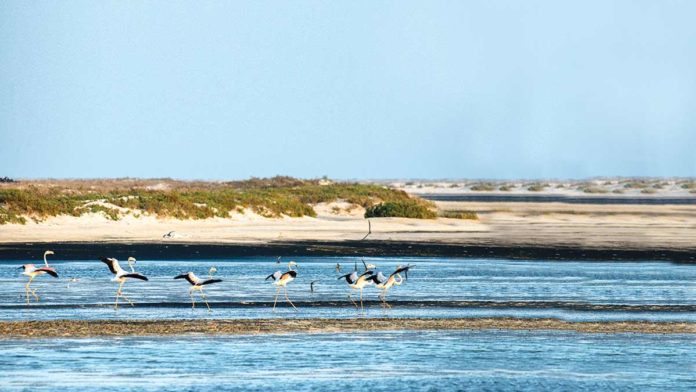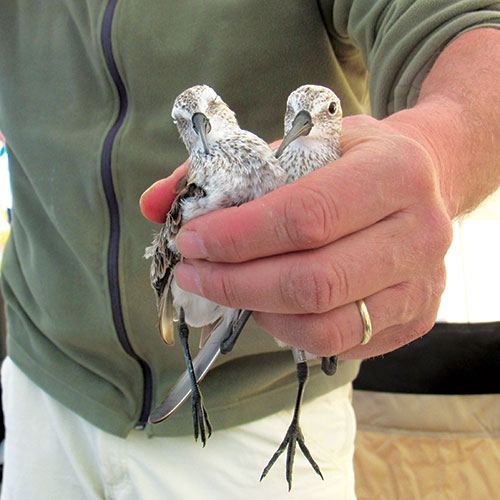The Barr Al Hikman peninsula occupies the largest part of the Al Wusta Wetlands Reserve with an area of approximately 900sqkms; it has significant regional and international importance as the main wintering and stop-over place for migratory shorebirds. It is classified as one of the top 25 sites of international importance for migratory birds during winter in the African-Eurasian Flyway.
In partnership with the Ministry of Environment & Climate Affairs, Shell Development Oman supported the first full Spring Migration count of the Wetlands Reserve in Al Wusta Governorate, which includes the Barr Al Hikman peninsula. The survey revealed that over 300,000 birds of approximately 80 different species have made the intertidal wetland their home for resting and feeding during their annual migration.
According to a press release issued by Shell Development Oman, the data collected by a team of 11 Dutch experts provides vital information for the conservation planning of the site. It also supports efforts by the Ministry of Environment and Climate Affairs to designate the Reserve as a Ramsar site (wetlands that are recognised as being of international importance), in addition to promoting a better understanding of how the Wetlands Reserve functions as an ecosystem for the waterbirds and other marine and terrestrial life that depend upon it throughout the year.
Supported, organised and conducted by Wetlands International, a global not-for-profit organisation dedicated to the conservation and restoration of wetlands, the survey is part of Shell’s ongoing commitment to promoting and sustaining biodiversity. Recognised as an Important Bird Area (IBA) by BirdLife International, the Wetlands Reserve in Al Wusta Governorate was declared as Nature Reserve by the Royal Decree No. 51/2014; it covers an area of 2621sqkms.
Globally, Shell has worked with Wetlands International since 2008 on projects that range from managing biodiversity and water issues at its operations in Iraq, Brunei and Canada to combining wetland conservation with the creation of sustainable livelihood opportunities for local communities in Nigeria.
Commenting on the Waterbird Survey in Oman, Ward Hagemeijer, Program Head Business and Ecosystems at Wetlands International, said, “This survey has produced critical information for successful management of Wetlands Reserve in Al Wusta Governorate and has brought the effective conservation of the treasures this area holds a step closer. An effective conservation management of the wetlands is a puzzle with many pieces. A few are already known and this March 2018 survey has added a new one. Several more pieces are still waiting to be looked into.”
Although the analysis of the collected data is still in progress, first impressions indicate that overall numbers of birds are lower in March than in January 2017. This is the result of a complex picture of birds leaving after spending the winter in the Wetland Reserves – departing to the breeding places – and the arrival of other birds that have spent their winter further South and are passing through the Wetland Reserves on their way North. It appears that more birds have left than have been replenished from the South.

The picture differs a lot per species. A number of species show lower numbers in March: the Lesser Sand Plover’s numbers are 80 per cent lower in March 2018 than in January 2017; Dunlin is 50 per cent lower. These are amongst the most common species at the Wetland Reserves and therefore have a large impact on the overall figures. The less numerous but very characteristic Crab Plover, a signature species, was found to be 90 per cent less than in January 2017. Large gulls and Cormorant were also far less numerous than in January. Curlew Sandpipers, on the other hand, have increased 4 fold. Most other species show less marked differences.
Besides the total count, other methods were deployed to disentangle the complex picture of species coming and going to and from the Wetland Reserve. Frequent counting of a small area, the counting of a sample-site, the ringing and colour-marking of waders shed new light on how the birds use the area. This work kick-started a multi-year research programme to support the effective management of the Wetland Reserve as a site of international importance. Complete findings from the first full Spring Migration count are to be published later in the year.


